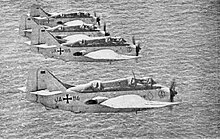Fairey Gannet
| Fairey Gannet | |
|---|---|

|
|
| Type: | Carrier -supported submarine fighter or AEW aerial reconnaissance aircraft |
| Design country: | |
| Manufacturer: | |
| First flight: |
September 19, 1949 |
| Commissioning: |
1955 |
| Number of pieces: |
348 |
The Fairey Gannet was developed by the British aircraft manufacturer Fairey Aviation in 1946 on behalf of the Royal Navy as the first carrier -based fighter aircraft with turbo- prop drive optimized for submarine hunting . Later versions were used for airborne airspace reconnaissance and surveillance ( English A irborne E arly W arning ; AEW). Gannet is the English word for gannets , a goose large seabird. The airplane was so named because it resembles this animal standing on the carrier with folded wings.
development
The first flight of the prototype took place on September 19, 1949, extensive test flights followed, the first deck landing took place in 1950. The test flights led u. a. to the fact that the original manning was increased from two to three men. In 1951, the series production of the AS3 version began and it was not until 1955 that the first upgraded series machines of the AS4 version were delivered to the British Navy and used on the aircraft carriers HMS Illustrious , HMS Ark Royal and HMS Eagle , where they released the Fairey Fireflies and Grumman Avengers from.
A total of 255 gannets were built at Fairey. In the 1970s, the gannets in the British Navy were replaced by the less space-consuming Westland Wessex helicopters . Gannets were in use in Australia and Indonesia until the 1980s.
Versions
| version | Role s. a. Designation system for aircraft used by the British armed forces |
Number (built) | comment |
|---|---|---|---|
| AS.1 | ASW ( english A NTI S ubmarine Warfare ) | 183 | |
| T.2 | Trainer version for AS.1 | 38 | 1 of which was converted from version AS.1 |
| AEW.3 | airborne air reconnaissance and surveillance ( English A irborne E arly W arning ) | 44 | 1 of which was converted from version AS.1 |
| AS.4 | Underground hunt | 75 | in the German Navy as AS.Mk4 |
| COD.4 | Carrier supply ( English C arrier O nboard D elivery ) | 6th | Conversion from AS.4 |
| T.5 | Trainer version for AS.4 | 11 | 3 of them converted from version T.2 |
| ECM.6 | Electronic warfare ( English E lectronic C ounter m easures ) | 9 | Conversion from AS.4 |
| AEW.7 | airborne reconnaissance and surveillance | 0 |
Technical specifications
| Parameter | Gannet AS.Mk4 |
|---|---|
| length | 13.57 m |
| span | 16.56 m / folded 5.94 m |
| height | 4.13 m / folded 4.19 m |
| drive | 1 × Armstrong Siddeley Double Mamba - turboprop engine (consisting of two Armstrong Siddeley Mamba, each driving one of the two coaxially arranged propellers in opposite directions) 2015 kW / 2740 PS |
| Marching speed | approx. 400 km / h |
| Top speed | 479 km / h |
| Normal range | 1600 km |
| crew | 3 |
| Service ceiling | 7620 m |
| Climb performance | 605 m / min |
| Empty mass | 6841 kg |
| Total mass | approx. 9000 kg |
| Armament | 2 torpedoes or 2 × 450 kg parachute mines, depth charges, 16 27 kg rockets, 10 sonoboys |
The second engine could be started after the first engine had started with the airflow from the propeller that was already turning.
Users
User states
- Indonesian Navy
Use in the German Navy

In 1958 the German naval aviators took over 16 machines, 15 of which were emergency aircraft and a T.5 trainer version (recognizable by the missing radome and the periscope in this version). On August 1, 1958, flight operations began as one of the first naval squadrons at Schleswig Air Base near Jagel .
Fairey Gannet were in service with Naval Aviation Squadron 2 and later with Naval Aviation Squadron 3 .
While it was being used by the German Armed Forces, there was a crash with three deaths on May 12, 1966 when an aircraft (registration number UA + 115 ) crashed near Oberbeuren immediately after taking off from the Kaufbeuren air base. The aircraft were replaced by the Breguet 1150 Atlantic in 1966 .
Preserved machines
In Germany, four machines are exhibited in the Air Force Museum of the Bundeswehr in Berlin-Gatow, the Speyer Technology Museum , the Hermeskeil flight exhibition and the Aeronauticum in Nordholz, further machines are in various foreign museums, and the XL502 machine existed in the late 1980s and now (2015) an airworthy gannet (XT752) in the USA .
See also
Web links
Individual evidence
- ^ Accident report Fairey Gannet UA + 115 , Aviation Safety Network (English), accessed on July 27, 2018.


